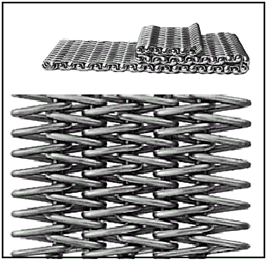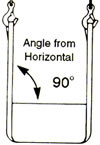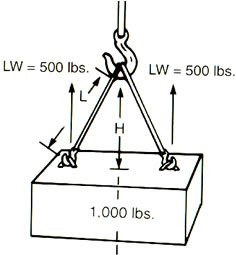
 |
ENGINEERED
STEEL PRODUCTS |
| Priced
Full Line Products Catalog |
20
Technology Way • West Greenwich, RI 02817
Toll free:(800) 421-0314 • In RI:(401) 272-4570 • Fax:(401)
421-5679 |
 |
|
|
 |
Back to Product Category
Roughneck WIRE MESH SLINGS
TYPE 2 |
Specialty
Slings with Particular Properties and Uses |
Widely used
in metalworking shops and steel warehouses where loads are abrasive, hot
or tend to cut web slings. |
|
|
|
|
Select
The Proper Mesh |
|
10
Gage-Heavy Duty |
12
Gage-Medium Duty |
|
 |
 |
|
|
|
|
|
|
|
|
Wire Mesh
Width (in.) |
Rated
Capacity (lbs.)* |
| Vertical |
Vertical
Basket |
10
Gage - Heavy Duty |
|
|
| Roughneck
Wire Mesh Sling Construction |
|
|
|
|
|
|
Standard
Construction:
Alloy steel end fittings, zinc plated. Mesh is galvanized high
tensile steel. 10 gage is standard, 12 gage is available upon
request. |
|
|
|
|
|
|
|
|
|
|
|
|
|
| 2 |
2,300 |
4,600 |
| 3 |
3,500 |
7,000 |
| 4 |
4,800 |
9,600 |
| 6 |
7,200 |
14,400 |
| 8 |
9,600 |
19,200 |
| 10 |
12,000 |
24,000 |
| 12 |
14,400 |
28,800 |
| 14 |
16,800 |
33,600 |
| 16 |
19,200 |
38,400 |
| 18 |
21,600 |
43,200 |
| 20 |
24000 |
48,000 |
|
|
Optional
Construction:
Stainless steel mesh is available for corrosive and hotter
environments. |
|
|
|
|
|
|
Inspection
Criteria for Wire Mesh Slings |
|
|
|
|
|
|
Remove the sling from service
if any of the following is
visible: |
|
|
|
|
|
|
 A broken weld or brazed joint along the sling edge A broken weld or brazed joint along the sling edge
|
|
|
|
|
|
|
 A broken wire in any part of the mesh A broken wire in any part of the mesh |
|
|
|
|
|
|
 Reduction in wire diameter of 25% due to abrasion or Reduction in wire diameter of 25% due to abrasion or
15% due to corrosion |
|
|
|
|
|
|
 Lack of flexibility due to distortion of the mesh Lack of flexibility due to distortion of the mesh |
|
|
|
|
|
|
 Visible distortion or wear of either end fitting Visible distortion or wear of either end fitting |
|
|
|
|
|
|
 Cracked end fitting Cracked end fitting
|
|
| 12
Gage - Medium Duty |
| 2 |
1,600 |
1,600 |
3,200 |
| 3 |
2,400 |
2,400 |
4,800 |
| 4 |
3,200 |
3,200 |
6,400 |
| 6 |
4,800 |
4,800 |
9,600 |
| 8 |
6,400 |
6,400 |
12,800 |
| 10 |
8,000 |
8,000 |
16,000 |
| 12 |
9600 |
9600 |
19,200 |
|
|
|
|
|
|
|
NOTE: The choker fitting must be positioned against a
load edge or directly on the triangle fitting. |
|
|
|
|
|
|
|
* |
|
|
|
|
 |
|
|
|
|
|
|
|
|
|
Do
not exceed rated capacities. Ratings must be reduced
when slings are used at angles of less then 30º from
horizontal. Follow instructions below. |
|
|
|
|
|
|
|
 |
|
|
|
 |
|
Order
Online, by Phone, or by E-Mail |
|
|
|
~ Add
items to your online shopping cart ~
Click a Price of the item you wish to purchase. |
|
|
Nominal
Width
(in.) |
Terminal
Dimensions
(in.) |
Terminal
Thick.
(in.)
10 GA |
Approx.
Wt. of
3 ft.
Slings
(lbs.)
10 GA |
Mesh
Wt.
(Per
ft. in
lbs.)
10 GA |
Extended
Prices @ Lengths Shown (ft.) |
Adder/
ft. |
| 3' |
4' |
5' |
6' |
8' |
10' |
12' |
14' |
16' |
18' |
20' |
| MW |
D |
IL |
TL |
| 2 |
2 |
3 |
3 7/8 |
1/2 |
6 |
1.3 |
|
|
|
|
|
|
|
|
|
|
|
$44.79 |
| 3 |
2 1/4 |
3 3/8 |
4 3/8 |
1/2 |
8 |
1.9 |
|
|
|
|
|
|
|
|
|
|
|
$48.84 |
| 4 |
3 |
4 |
5 |
1/2 |
10 |
2.5 |
|
|
|
|
|
|
|
|
|
|
|
$52.52 |
| 6 |
3 1/2 |
4 1/2 |
5 5/8 |
1/2 |
16 |
3.9 |
|
|
|
|
|
|
|
|
|
|
|
$60.69 |
| 8 |
4 1/2 |
6 |
7 1/2 |
1/2 |
22 |
5.1 |
|
|
|
|
|
|
|
|
|
|
|
$66.21 |
| 10 |
4 3/4 |
6 1/4 |
8 |
1/2 |
28 |
6.4 |
|
|
|
|
|
|
|
|
|
|
|
$73.75 |
| 12 |
5 |
6 1/2 |
8 5/8 |
1/2 |
34 |
7.6 |
|
|
|
|
|
|
|
|
|
|
|
$80.45 |
| 14 |
5 |
6 1/2 |
8 3/4 |
1/2 |
40 |
8.9 |
|
|
|
|
|
|
|
|
|
|
|
$89.52 |
| 16 |
5 1/4 |
7 |
9 1/8 |
3/4 |
57 |
10 |
|
|
|
|
|
|
|
|
|
|
|
$98.31 |
| 18 |
5 1/2 |
7 1/2 |
9 3/4 |
3/4 |
67 |
11 |
|
|
|
|
|
|
|
|
|
|
|
$106.68 |
| 20 |
5 3/4 |
7 3/4 |
10 1/8 |
3/4 |
77 |
13 |
|
|
|
|
|
|
|
|
|
|
|
$114.59 |
| Type
2 - 12 Gage |
Nominal
Width
(in.) |
Terminal
Dimensions
(in.) |
Terminal
Thick.
(in.)
12 GA |
Approx.
Wt. of
3 ft.
Slings
(lbs.)
12 GA |
Mesh
Wt.
(Per
ft. in
lbs.)
12 GA |
Extended
Prices @ Lengths Shown (ft.) |
Adder/
ft. |
| 3' |
4' |
5' |
6' |
8' |
10' |
12' |
14' |
16' |
18' |
20' |
| MW |
D |
IL |
TL |
2 |
2 |
3 |
3
7/8 |
1/2 |
5 |
1.1 |
|
|
|
|
|
|
|
|
|
|
|
$57.50 |
3 |
2
1/4 |
3
3/8 |
4
3/8 |
1/2 |
8 |
1.8 |
|
|
|
|
|
|
|
|
|
|
|
$61.99 |
4 |
3 |
4 |
5 |
1/2 |
10 |
2.3 |
|
|
|
|
|
|
|
|
|
|
|
$65.38 |
6 |
3
1/2 |
4
1/2 |
5
5/8 |
1/2 |
14 |
3.4 |
|
|
|
|
|
|
|
|
|
|
|
$74.20 |
8 |
4
1/2 |
6 |
7
1/2 |
1/2 |
21 |
4.5 |
|
|
|
|
|
|
|
|
|
|
|
$79.08 |
10 |
4
3/4 |
6
1/4 |
8 |
1/2 |
26 |
5.6 |
|
|
|
|
|
|
|
|
|
|
|
$86.46 |
12 |
5 |
6
1/2 |
8
5/8 |
1/2 |
32 |
6.8 |
|
|
|
|
|
|
|
|
|
|
|
$92.66 |
|
|
| Prompt
Shipment or Repair Service by Experts |
| Wire
Mesh Sling Repairs |
Wire
Mesh
Width |
Basic Repair Charge |
New Triangle Fitting |
New Choker Fitting |
New
Mesh Per
Foot of Length |
| 10 GA. |
12 GA. |
| 2" |
$53.42 |
$58.41 |
$84.65 |
$44.79 |
$57.49 |
| 3" |
$58.41 |
$76.51 |
$120.65 |
$48.84 |
$61.98 |
| 4" |
$64.28 |
$115.67 |
$198.63 |
$52.51 |
$65.38 |
| 6" |
$80.09 |
$153.02 |
$215.27 |
$60.69 |
$74.19 |
| 8" |
$98.27 |
$177.42 |
$264.45 |
$66.20 |
$79.08 |
| 10" |
$114.55 |
$221.18 |
$364.48 |
$73.75 |
$86.46 |
| 12" |
$132.80 |
$299.61 |
$449.91 |
$80.45 |
$92.66 |
|
|
|
Contact
us to order |
|
|
Wire
mesh slings with normal usage will eventually need repair and parts replaced.
This can be done for relatively
small cost. Wire mesh slings that are repaired are guaranteed to meet or
exceed original specifications. Five factories
are strategically located in the U.S. to insure prompt service. We repair
all types and brands of mesh slings. |
|
| Effect
of Angle of Lift on a Sling's Rated Capacity |
|
|
|
|
|
|
|
|
DEFINITION |
|
|
|
|
|
|
|
|
serves
to alert users to potentially hazardous situations which often occur in
the use of these products.
Failure to read, understand and follow the accompanying instructions on
how to avoid these situations
could result in death or serious injury. |
 |
|
|
|
|
Using
slings at an angle can become deadly if that angle is not taken into consideration
when selecting the sling
to be used. The tension on each leg of the sling is increased as the angle
of lift, from horizontal, decreases. It is
most desirable for a sling to have a larger angle of lift, approaching 90°.
Lifts with angles of less than 30° from
horizontal are not recommended. If you can measure the angle of lift or
the length and height of the sling as rigged,
you can determine the properly rated sling for your lift. |
|
|
|
|
|
|
|
|
|
|
|
|
|
|
|
|
|
What
would be the rating of each sling
rigged at this angle? |
|
 |
|
|
 |
|
What
capacity sling do I need? |
|
|
|
|
|
|
|
|
|
|
|
|
|
1.
Determine the weight that the sling
will be lifting [LW]. |
|
|
|
|
|
|
|
|
| 1.
Calculate the Reduction Factor [RF]. |
|
|
|
|
|
|
|
|
|
|
|
|
|
|
|
|
|
|
a.
Using the angle from horizontal,
read across the Angle Chart to the
corresponding number of the
Reduction Factor column. |
|
|
|
|
2.
Calculate the Tension Factor [TF]. |
|
|
|
|
|
|
|
|
|
|
|
|
|
|
|
|
|
a.
Using the angle from horizontal,
read across the angle chart to the
corresponding number of Tension
Factor column. |
|
|
|
|
|
|
|
|
|
|
|
-OR- |
|
|
|
|
|
|
|
|
|
|
|
|
|
|
|
|
|
|
|
b.
Divide sling height* [H] by sling
length* [L]. |
|
|
|
|
|
|
|
|
|
|
|
|
|
|
|
|
-OR- |
|
|
|
|
|
|
|
|
|
|
|
|
|
|
|
|
|
b.
Divide sling height* [H] by sling
length* [L]. |
|
|
|
|
|
Choker
Hitch |
|
Vertical
Hitch |
|
2.
Reduction Factor [RF] x the sling's
rated capacity for the type hitch that
will be used = Sling's Reduced Rating. |
|
|
|
|
|
|
|
|
|
|
|
|
|
|
|
 |
|
|
|
|
|
|
|
|
|
|
|
|
|
|
|
|
|
3.
Lifting Weight [LW] x the Tension
Factor [TF] = Minimum Sling Rating
for the type of hitch that will be used. |
|
|
|
Vertical
Basket
Hitch |
|
|
*Measured
from a common horizontal plane to
the hoisting hook. |
|
|
|
|
|
|
|
|
|
|
|
|
|
*Measured
from a common horizontal
plane to the hoisting hook. |
|
|
|
|
|
|
|
|
|
|
|
|
|
|
|
|
|
|
|
|
|
|
|
|
|
|
|
|
|
|
Reduced
Capacity |
|
|
|
|
|
|
|
|
|
|
|
Effect
of Angle Chart |
|
Increasing
Tension |
 |
|
|
|
Reduction
Factor |
Angle
From
Horizontal |
Tension
Factor
(TF) |
| 1.000 |
90° |
1.000 |
| 0.996 |
85° |
1.004 |
| 0.985 |
80° |
1.015 |
| 0.966 |
75° |
1.035 |
| 0.940 |
70° |
1.064 |
| 0.906 |
65° |
1.104 |
| 0.866 |
60° |
1.155 |
| 0.819 |
55° |
1.221 |
| 0.766 |
50° |
1.305 |
| 0.707 |
45° |
1.414 |
| 0.643 |
40° |
1.555 |
| 0.574 |
35° |
1.742 |
| 0.500 |
30° |
2.000 |
|
|
 |
Example:
Vertical Choker rating of each sling = 6,000 lbs.
Measured Length (L) = 6 ft.
Measured Height (H) = 4 ft.
Reduction Factor (RF) = 4 (H) ÷ 6 (L) = .667
Reduced sling rating in this configuration = .667
(RF) x 6,000 lbs. = 4,000 lbs. of lifting capacity
per sling |
|
|
|
|
Example:
Load Weight = 1,000 lbs.
Rigging - 2 slings in vertical hitch
Lifting Weight (LW) per sling = 500 lbs.
Measured Length (L) = 10 ft.
Measured Height (H) = 5 ft.
Tension Factor (TF) = 10 (L) ÷ 5 (H) = 2.0
Minimum Vertical Rated Capacity required
for this lift = 500 (LW) x 2.0 (TF) = 1,000
lbs. per sling |
|
Sling
capacity decreases as the angle
from horizontal decrease. Sling angles
of less than 30° are not recommended. |
|
|
|
|
|
|
|
|
|
|
|
|
|
|
|
|
|
|
|
|
|
|
|
Wire Mesh Slings, Lifting
Slings, Lift-All, Sling, 10 Gage-Heavy Duty, 12 Gage-Medium Duty, Steel
Construction,
Stamped with Capacity and Serial Number, Sling Proof Tested and Certified,
Grips Load firmly without stretching,
Resists Abrasion, and Mesh is Galvanized from your source for material
handling equipment. |
Back
to Product Category |
 |
|
















